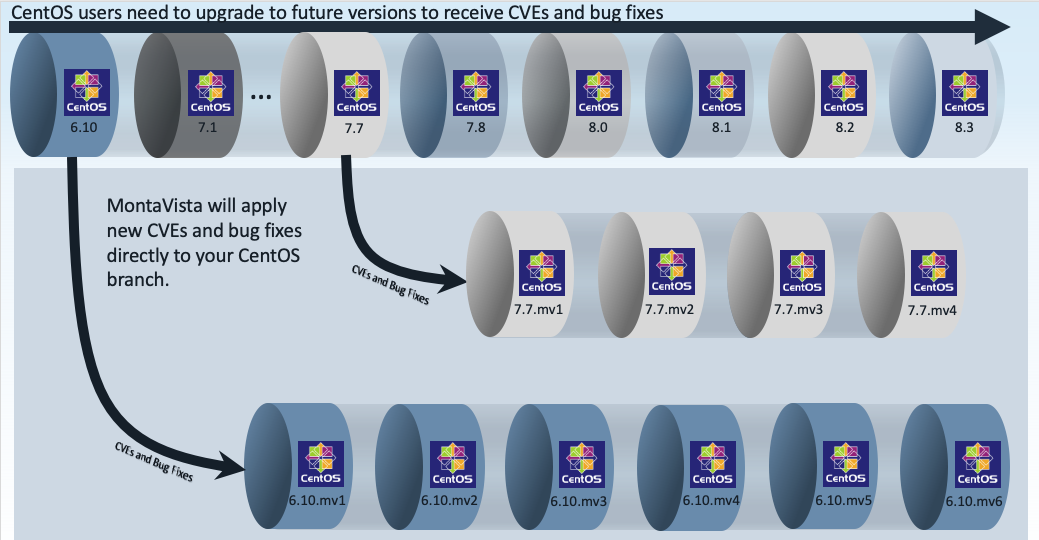CentOS 6.10, all good things need not come to an end
CentOS 6가 6.10 릴리스와 함께 수명 종료(EOL)된다고 발표되었을 때, 어떤 사람들은 아마도 "글쎄, 모든 좋은 일은 끝나야 하잖아."라고 생각했을 것입니다. 오래 걸리지는 않았지만, 업그레이드에 대한 광란의 공지, 블로그, 커뮤니티 경고가 즉시 나왔고 이제 엔지니어링 팀은 CentOS 7 또는 8로의 마이그레이션 계획을 확정하고 구현하기 위해 서두르고 있습니다. 아니면 다른 Linux 플랫폼으로. 많은 사람들이 마지못해 ...
하지만 CentOS 6.10 지원이 종료되지 않아도 된다면 어떨까요? 이를 통해 제품 팀은 고객 기반에 대해 보다 통제되고 계획된 마이그레이션 전략을 구현할 수 있는 여유를 가질 수 있으며, 더 중요한 것은 이미 실행 가능한 견고한 제품의 수명을 연장할 수 있습니다.
어떻게 이를 달성할 수 있을까요? 사내에서 이를 수행하려면(CentOS 커뮤니티가 11월 이후에는 지원하지 않기 때문에) 지속적 통합 플랫폼과 다음으로 구성된 팀을 만들어야 합니다.
- 장점: CVE 및 버그 식별 프로세스와 엔지니어링 팀이 끌어와 확인
- 전문가: 통합, 백포트 및 문제 해결을 위한 패키지, 툴체인 및 커널 전문가(사소해 보이지만 그렇지 않음)
- 기반: 인프라 및 일일/주간/월간 빌드 실행 팀
- 핵심 품질: 품질 보증 테스트 플랫폼(테스트 하네스, 예약 시스템, 콘텐츠, 실행 및 분석) 및 테스트 팀
- 마지막으로 제품 출시 팀
조립이 불가능한 것은 아니지만, 깊이와 전문성을 갖추는 데 시간이 걸릴 수 있으며 다른 개발 계획에 확실히 영향을 미칠 것입니다. 말할 것도 없이, 한두 명의 엔지니어가 풀타임으로 일하더라도 이를 수행할 수 없습니다.
또는 MontaVista Software를 찾아 필요한 모든 CentOS 유지 관리 전문 지식을 얻을 수 있습니다. MontaVIsta Software는 이제 EOL CentOS 6.10 Linux 브랜치에 대한 확장 지원을 제공합니다. 우리는 매우 효율적인 CI/CD(Continuous Integration/Continuous Delivery) 인프라를 구축했습니다. 이를 통해 CVE를 가져와 다양한 Linux 브랜치(예: 우리 브랜치, CentOS 등)에 적용하고 필요한 경우 백포팅하고 빌드한 다음 강력한 QA 테스트 주기를 거칠 수 있습니다. 우리는 백포팅, 패키지 유지 관리, 배포 통합 및 테스트의 뉘앙스를 이해하는 기술적 전문 지식과 심층적인 지원 지식을 보유하고 있습니다. 우리는 Linux 전문가(찾기 힘든)이며 Linux CI/CD 지식 수준을 개발하고 달성하는 데 몇 년이 걸립니다.
MontaVista는 1999년부터 임베디드 Linux 배포판에 대한 장기 확장 Linux 지원을 제공해 왔습니다. 일반적인 제품 수명 주기는 10년이지만, 15년 이상 지원해 온 제품도 있습니다.
2013년부터 MontaVista는 CentOS를 지원해 왔습니다. MontaVista는 CVE 및 버그 수정을 통해 CentOS 브랜치(6.10, 7.5, 8.1 등)를 유지 관리합니다. 이 유지 관리 작업은 고객의 특정 CentOS 브랜치에 대해 수행되므로 MontaVista는 필요한 경우 새로운 CVE를 CentOS 브랜치에 적용하고 백포트합니다. 이는 CVE 및 버그 수정 패치를 받으려면 최신 CentOS 버전으로 업그레이드해야 하는 표준 CentOS에서 벗어난 것입니다. (아래 그림 1 참조). 따라서 현재 CentOS 6.10 기반 제품을 배포하고 있다면 필요한 보안 업데이트를 계속 받는 동안 필요한 기간 동안 이 배포판을 계속 사용할 수 있습니다. MontaVista는 또한 미리 정해진 해결 방법 또는 수정 기간 동안 CentOS 6.10의 높은 우선 순위 CVE에 대한 수정을 보장하기 위해 서비스 수준 계약(SLA)을 제공할 수 있습니다.

그림 1
CentOS 6.10 지원을 연장하면 여러 옵션과 이점이 있습니다. 첫째, CentOS 6 기반 제품을 계속 판매하고 지원하여 수익 흐름을 늘리고 이익 마진과 고객 만족도를 높일 수 있습니다. 사실 MontaVista를 사용하면 고객이 요구하는 한 CentOS 6.10 브랜치를 계속 지원할 수 있습니다. 이제 EOL "유령"이 더 이상 제품 수명 주기를 맴돌지 않으므로 현재 고객을 새로운 버전의 CentOS를 기반으로 하는 새로운 제품 및 솔루션으로 마이그레이션하는 방법을 전략적으로 계획할 수 있습니다. 이를 통해 엔지니어링 팀은 마이그레이션 또는 신제품 개발 비용과 일정을 평가할 수 있습니다. 더 중요한 것은 MontaVista를 사용하여 CentOS 6.10 브랜치를 지원하는 경우 새로운 제품 전략이 CentOS 6.10 유지 관리 문제로 인해 주의가 산만해지지 않으므로 전체 엔지니어링 인재와 개발 직원을 확보할 수 있다는 것입니다.
2020년 11월 30일이 빠르게 다가오고 있으므로 현재 제품이 CentOS 6.10을 사용하는 경우 앞으로 어떻게 지원할지 선택해야 합니다. CI/CD 전문성과 CentOS 서비스를 갖춘 MontaVista와 협력하면 좋은 것을 조금 더 오래 "진행"할 수 있습니다.
MontaVista의 CentOS용 MVShield에 대해 자세히 알아보려면 여기에서 자세한 정보를 찾을 수 있습니다. 또는 CentOS 6.10 기반 제품을 최신 상태로 유지하고, 안전하고, 실행 가능하게 유지하는 방법에 대해 논의하고 싶으면 저희에게 연락하세요 .















